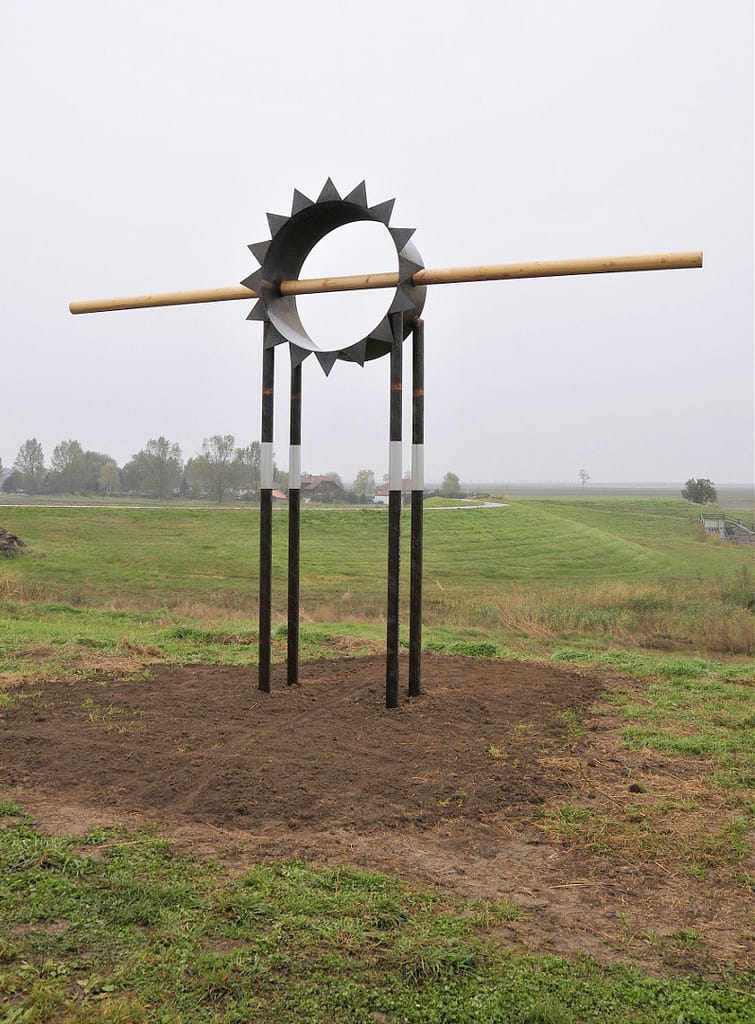For centuries, mills were central machines and places of human culture, the astonishing thing is that little has changed in their already quite early developed basic construction for a long time. This speaks for the coherence and also the necessity of this construction. The basic idea of the monument is to divide this construction into its essential parts, and to dedicate an object to the respective part. The mills are now “released” and themselves damned to unemployment. As we walk along their monument, recreationally, they are adapted and rebuilt, lapsed or demolished and finally allow us not to see them in the context of the world of work. Redundancy on the one hand, free time on the other hand but as Marx already diagnosed, idleness is not included. And so the walk along the monument to the watermills gets another touch. With the unrivaled ideal of leisure, it commemorates a true “passion extravagant”: the love of work, which, like Karl Marx’s son in law Paul Lafargue, was an addiction of the workers and the true cause of their enslavement. Instead of enjoying leisure in the ancient sense physical exercises and games of the mind they rotated completely nonsensical, economically and individually, in the cycle of effort, without enjoying the fruits of their work: “(M) must be the overzealous passion of the workers for the Taming work and forcing it to consume the goods that produce it.“ (Eva Kernbauer)

Triebwerk (Power Unit) / 2010 / armored concrete / 1500 x 200 x 180 cm / Part of: Denkmal für die Wassermühlen (Watermill’s Monument) / Art in Public Space / Roseldorf
The Triebwerk demonstrates the use of the force of gravity, and on closer consideration, the mostly forgotten rotation of our planet earth. The imagination of the enormous forces that hold her, Gaia. in its, her, quite stable position, pushes quickly to its limits. The Triebwerk is a solid concrete cast inclined plane on which 12 vertical plates interrupt direction of flow made to be felt. From the twelfth plate Triebwerk disappears into the earth, connecting the power of movement with the drama of disappearing. At one point the following inscription is cast: AND_YET_SHE_TURNS_1600 / 33, quoting Galileo Galilei, a dedication and an astonishment.

Kammradach (Cogwheelroof) / 2010 / iron, wood, metal, steelsheet chromeplated / 420 x 170(700) x 65 cm / Part of: Denkmal für die Wassermühlen (Watermill’s Monument) / Art in Public Space / Roseldorf
The Kammradach was influenced by the protective roof of an existing historical sculpture. A kind of sky’s mill is suggested. Left to protect is an empty point of power transmission. A 7 meter long axis pierces the Kammradach. Inscribed on one of the legs near the ground: HERE IT IS NOT DIFFERENT THAN THERE_1905 A slightly modified sentence from the popular Petersburg Revue Days of Freedom (Dni Swobody). Basic movements of the theater of the 20th century should have their origin in the context of this revue (1905), not least the little later influential opera Victory over the Sun.

Dach (Roof) / 2010 / iron, steel sheet, engraving / 105 x 64 x 52 cm / Part of: Denkmal für die Wassermühlen (Mill’s Monument) / Art in Public Space / Roseldorf
The historic mercy seat, whose roof was put in dialogue with the Kammradach, is flanked by two young birches. The column is a little cramped, at times it is even “swallowed” by the birch leaves. The inclusion of the older existing sculpture in the overall constellation is becoming apparent, as it is a witness to the times when the Mühlbach, the little river feeding the mill, still made the picture of the landscape look different. The roof that protects the stone column has been renewed true to the original. The execution of the spikes was done in a way to highlight their presence: half as many in number, they are twice as high. An appropriation. The following is inscribed inside the new roof:
and we are now shadows / that cling to each other / but kiss the air only (1967)
An excerpt from a poem by African writer Christopher Okigbo. He describes the moon, which rises between two mutually bending pines. It seemed also important to acknowledge a different voice from not only distant times, written in the a little foreign sounding language.

Laterne (Lantern) / 2010 / iron pipe, concrete, wood / 700 x diam.133 cm / Part of: Denkmal für die Wassermühlen (Mill’s Monument) / Art in Public Space / Roseldorf
The stick gear of an original mill translates the force of the movement in the ultimately useful direction by means of the Lantern, thus driving the respective work process. Today’s work in the old Roseldorfer Mühle (Integrative home for young people) is highly alive. Obvious is a gesture of respect and appreciation, not only of the work there, but elsewhere, and, or the appreciation of rest and even uselessness in general. In the mill, the movement is translated by the comb wheel of the lantern, and deflected in the direction ultimately needed. In our case, the stick gear points in the direction of the hidden water vein. We are still in the area along the former Mühlbach, and here, at the end of an imaginary complete mill factory, a return of the water may be heard. Cast in the millstone: THE FORCE HAS A PRICE_1808 The sentence of Joseph Montgolfier should be a marker and reference: to the heyday or the key moment of industrial mechanics, whose significant machines were the mills. The rule of industry and efficiency claim arose with these times and lines. The rapid economization of forces, their use and their assessability, was subsequently pursued with unprecedented intensity. This development ultimately led to the disappearance of the mills.




